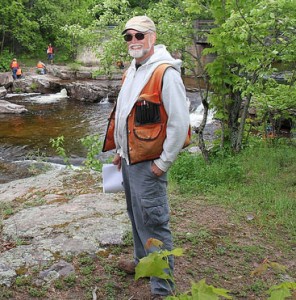“Bittersweet.”
That’s Professor Ted Bornhorst’s assessment of just finishing his last summer field course in geology. After 32 years, it’s been a lot of miles, smiles, and students.
“It was roughly 600 students over the years,” he says. “All geology, geological engineering, and geophysics majors take the course.”
The course actually goes back at least into the 1930s and 1940s, and the legendary Kiril Spiroff taught it for multiple years followed by Steve Nordeng. (Coincidently, Bornhorst took one of Spiroff’s last classes and took field geology from Steve Nordeng.)
Both Bornhorst and his wife, Laurie, are Michigan Tech alums who took the class, and together they scoped out the sites then being used for mapping and field study. Some of those initial sites not only remain in the class today but used were used long ago too. Field sites used in the class have changed in location and emphasis over the 32 years.
“We still visit the South Range quarry, a field site used for at least 60 years,” he says. “A lot of our time now takes place east of L’Anse today.”
Regardless of location, students are exposed to many different problems: identifying and mapping in the field, Bornhorst says.
Recently, their travels took them to the Best Buy store in Marquette, where an unruly boulder came crashing down. There, he ran into a couple of former students Allan Blaske with GEI consultants and Jamie Matus ’84. He ran into a bizarre coincidence, too. “Before that trip, I couldn’t find my latest map of the region, so I grabbed a folder of old maps that happened to include those created during my first years teaching the course,” Bornhorst says. “Sure enough, the maps dated to 1983 and 1984, the years that Matus and Blaske took the course from me!”
As for the students he’s seen over the years, “I’ve most enjoyed getting to know them as people,” he says. “We are together from 8:00 to 6:00 for five weeks. I enjoy seeing them mature, develop, and improve. I’ve always taught continuous improvement.”
In fact, one alumnus credited Bornhorst with teaching him continuous improvement concepts that he uses in his successful business every day. “It’s great to hear that.”
Important habits are developed in the course, he says: collecting data, developing multiple hypotheses, and testing those hypotheses with the data.
“You have to learn to make good at observations and apply them to solving problems in teams and individually.” He stresses, “You have to push yourself to get better and better.”
As he takes his leave, Bornhorst says it’s important to continue the course as a local geology field camp, as it becomes the geologic “home” for graduates. Many universities send their students to field camps some distance from campus, often in the western US.
“Here, they learn firsthand the geologic story of the area where their school is located,” he says. “They are better connected to the area and the University.”
While less emphasized in the beginning, his most important lesson now, day after day, to all those students?
He stands and puts one finger in the air.
“Safety,” he says. “I harp and I harp and I harp on it. It’s the first thing we do every morning. ‘What’s rule number one?’ They all put up their finger and say, ‘Safety!’ And as part of safety that’s why they map with a partner, and they all learn to use a compass so that they can always find their way out.”
Assistant Professor Chad Deering will be taking over the field course, Bornhorst says. Odds are, he’ll be stressing safety too, and just perhaps he too will hold up his finger in the morning air.
Dennis ’92 ’09

